The AMD Ryzen 7 5700G, Ryzen 5 5600G, and Ryzen 3 5300G Review
by Dr. Ian Cutress on August 4, 2021 1:45 PM ESTMicrobenchmarks
Core-to-Core Latency
As the core count of modern CPUs is growing, we are reaching a time when the time to access each core from a different core is no longer a constant. Even before the advent of heterogeneous SoC designs, processors built on large rings or meshes can have different latencies to access the nearest core compared to the furthest core. This rings true, especially in multi-socket server environments.
But modern CPUs, even desktop and consumer CPUs, can have variable access latency to get to another core. For example, in the first-generation Threadripper CPUs, we had four chips on the package, each with 8 threads, and each with a different core-to-core latency depending on if it was on-die or off-die. This gets more complex with products like Lakefield, which has two different communication buses depending on which core is talking to which.
If you are a regular reader of AnandTech’s CPU reviews, you will recognize our Core-to-Core latency test. It’s a great way to show exactly how groups of cores are laid out on the silicon. This is a custom in-house test built by Andrei, and we know there are competing tests out there, but we feel ours is the most accurate to how quick an access between two cores can happen.
The Ryzen 7 5700G has the quickest thread-to-thread latency, however does offer a single slowest core-to-core latency. But compared to the 4000G series, having a single unified L3 cache reduces to core-to-core latency a good amount. The Ryzen 5 5300G has the slowest intracore latency, but the fastest average core-to-core.
Per-Core Power
One other angle to examine is how much power each core is drawing with respect to the rest of the chip. In this test, we run POV-Ray with a specific thread mask for a minute, and take a power reading 30 seconds into the test. We output the core power values from all cores, and compare them to the reported total package power.
The peak per-core power is shown as 15.2 W when one core is loaded on the Ryzen 7 5700G, and that comes down to ~8.8W when all cores are loaded. Interestingly this processor uses more power when six cores are loaded.
The Ryzen 5 5300G starts at 11.5 W for a single core, but then moves up to 12.3 W when three cores are loaded. It comes back down to 11.5 W when all four cores are loaded, but this ensures a consistent frequency (the 5300G has a 4.2 GHz Base and 4.4 GHz Turbo, explaining the small variation in loading).
Frequency Ramping
Both AMD and Intel over the past few years have introduced features to their processors that speed up the time from when a CPU moves from idle into a high-powered state. The effect of this means that users can get peak performance quicker, but the biggest knock-on effect for this is with battery life in mobile devices, especially if a system can turbo up quick and turbo down quick, ensuring that it stays in the lowest and most efficient power state for as long as possible.
Intel’s technology is called SpeedShift, although SpeedShift was not enabled until Skylake.
One of the issues though with this technology is that sometimes the adjustments in frequency can be so fast, the software cannot detect them. If the frequency is changing on the order of microseconds, but your software is only probing frequency in milliseconds (or seconds), then quick changes will be missed. Not only that, as an observer probing the frequency, you could be affecting the actual turbo performance. When the CPU is changing frequency, it essentially has to pause all compute while it aligns the frequency rate of the whole core.
We wrote an extensive review analysis piece on this, called ‘Reaching for Turbo: Aligning Perception with AMD’s Frequency Metrics’, due to an issue where users were not observing the peak turbo speeds for AMD’s processors.
We got around the issue by making the frequency probing the workload causing the turbo. The software is able to detect frequency adjustments on a microsecond scale, so we can see how well a system can get to those boost frequencies. Our Frequency Ramp tool has already been in use in a number of reviews.
In our test, the Ryzen 5 5600G jumps from 2700 to the turbo frequency in around a millisecond.


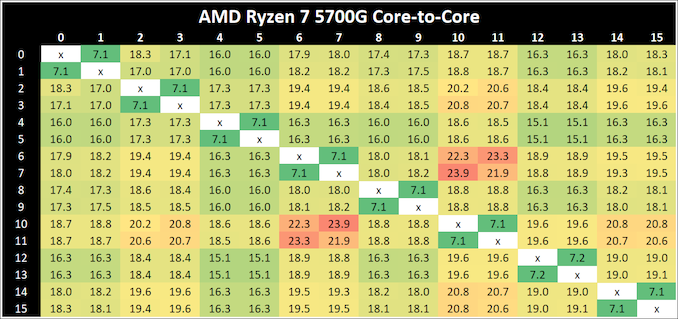
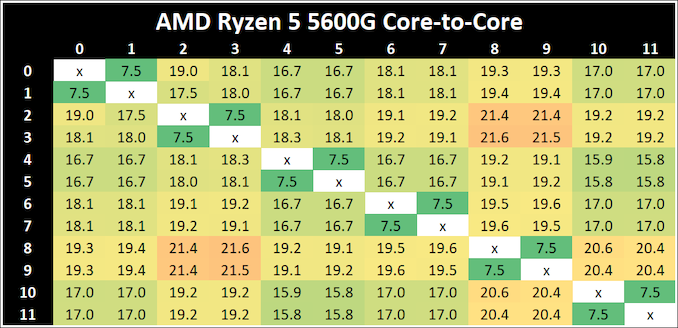
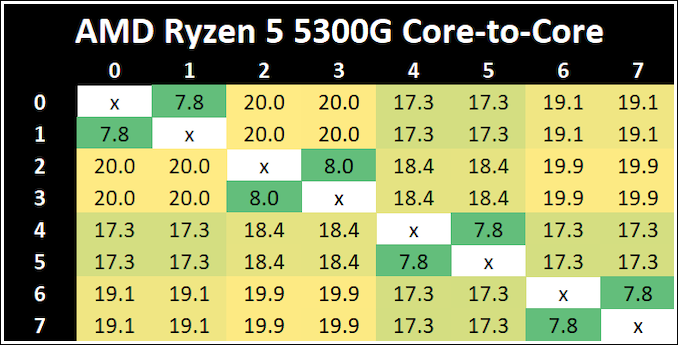
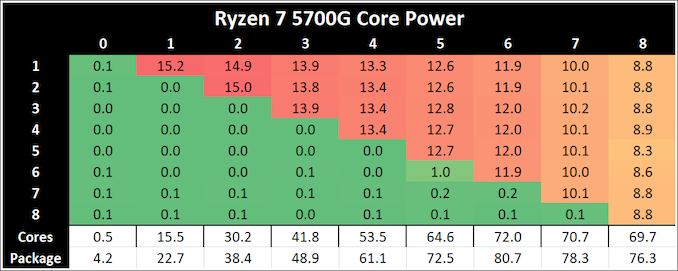

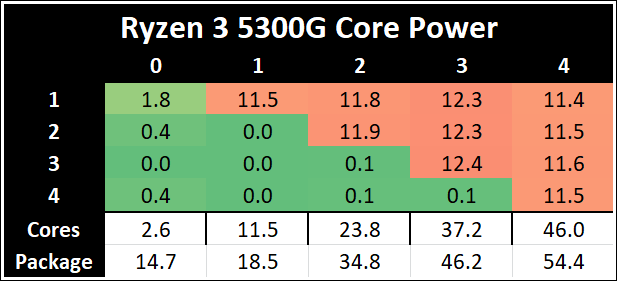
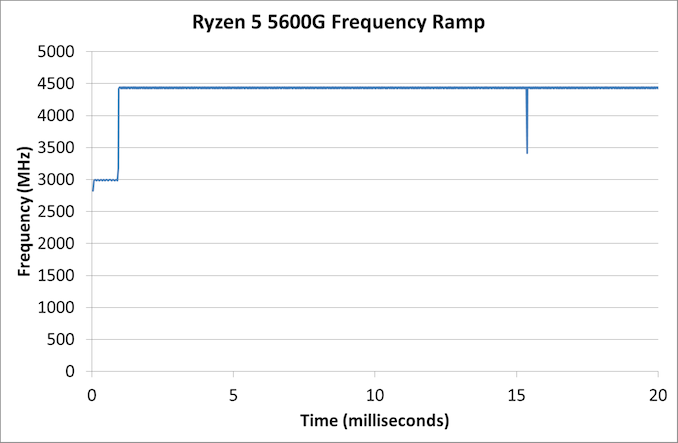








135 Comments
View All Comments
linuxgeex - Wednesday, August 4, 2021 - link
There's a silly number of errors in the first page of this review. The 5600G does not have "8 cores". Intel didn't "cut" AMD products from the market. Cezanne processors don't use "Zen 3 graphics".Please proof your work, we expect better from Anandtech.
The_Assimilator - Thursday, August 5, 2021 - link
"we expect better from Anandtech"If you've been around since Anand left, you really shouldn't. I don't know who's nominally in charge nowadays but they CBA to perform basic proofreading on most articles.
Machinus - Wednesday, August 4, 2021 - link
When are we going to see 16-20 CUs? Then you could really say you're replacing a GPU.nandnandnand - Wednesday, August 4, 2021 - link
Rembrandt will have RDNA 2 and up to 12 CUs, which should provide acceptable 1080p performance. It will fall short of the Xbox Series S, but not by too much if the graphics clock is higher. It will also have DDR5, better I/O, AV1 decode, etc.Imagine if a Ryzen 7 6700G (OEM) came out in the next 8 months or so.
cigar3tte - Wednesday, August 4, 2021 - link
Will Rembrandt run on AM4 still?nandnandnand - Wednesday, August 4, 2021 - link
DDR5 = AM5. In fact, maybe it will end up being the very first CPUs on AM5.vlad42 - Thursday, August 5, 2021 - link
As I mentioned above, Rembrandt will likely use RDNA1 instead of RDNA2. Drivers for an RDNA1 based APU were just submitted to the Linux kernel a few days ago.nandnandnand - Thursday, August 5, 2021 - link
See above. Rembrandt will use RDNA 2. It might be referred to as "Yellow Carp".https://www.tomshardware.com/news/amd-begins-to-en...
https://www.phoronix.com/scan.php?page=news_item&a...
Fulljack - Wednesday, August 4, 2021 - link
since Van Gogh (Steam Deck) uses 8CU of RDNA2, I think the next generation of APU (Rembrandt) will also features 8CU. Although the moves to DDR5 and possible inclusion of 3D cache (similar to infinity cache) will help performance a lot.This is all are rumour, though.
nandnandnand - Wednesday, August 4, 2021 - link
Rembrandt should have up to 12 CUs. With higher bandwidth from DDR5, perhaps integrated graphics performance will be doubled from the 5800H/5700G. 1080p60 should be achievable in many games, with some settings turned down.I do not expect Rembrandt to have Infinity Cache, 3D V-Cache, L4 cache/HBM, or increased cache whatsoever (Cezanne already doubled from Renoir, and quadrupled the amount each core could access). Any cache improvement would be a pleasant surprise.